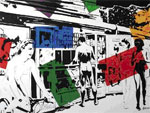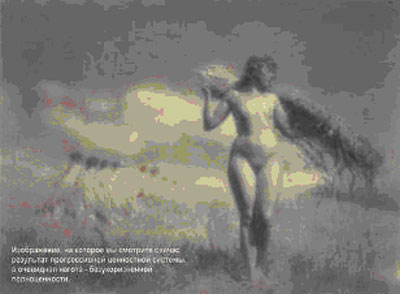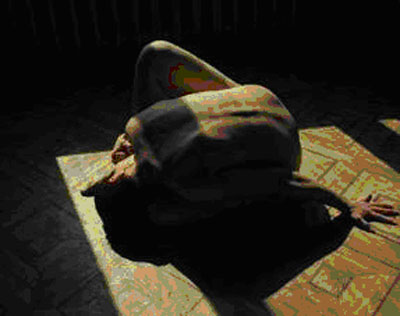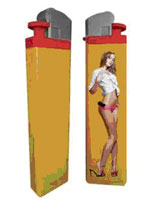Frontal Nudity
 Arman Grigoryan
Arman Grigoryan
I would like to begin my essay towards the Frontal Nudity project with a quote from the memoirs of a Ivan Neumivakin, a medical doctor and member of the academy, published in 2007 in his book The Ecology of Health. After the collapse of the Soviet Union Ivan Neumivakin traveled to a spa in Baden-Baden with his wife, where they visited an oriental bath, only to discover that women and men used the same steam room and pool, completely naked.
Here is what Neumivakin has to say about it: “Even I, a medical doctor, experienced this strange sensation when I saw people all around me who were free not only in their spirit, but also the body. Everyone, whether male or female, behaved naturally. Our attention was drawn to the fact that practically everybody’s abs were taut, and most bodies were fit. It is only natural for a naked person to crave a pleasing look. Isn’t this what especially men do on the beach when they spot an attractive lady: pulling up the slack of their tummy? When we shared our feelings with our German friends next morning, politeness made them refrain from telling us that it was only because we came from an uncultivated country, where puritan upbringing had stuffed our minds with Communist complexes.” As a rule societies that openly display and appreciate the naked body are progressive, tolerant and rich. They enjoy advances in art, science and medicine; they have beautiful and comfortable cities and hamlets. This was the case in the ancient world, and it still holds true. Instruction in fine arts is based on the experience of observing a naked human body for a lengthy period of time (the naked model is watched in the same posture for fifty hours or more). This teaches the artist to perceive the world around and himself in it. This is an approach we have inherited since the Renaissance, it embodies great optimism and cheerfulness, stimulates imagination and initiative. These are qualities very much in demand today. Fine arts in Armenia developed explosively through the Soviet years. Armenian artists of varying aptitude and educational level hastened to converge from all over on their motherland, which had flung down the gauntlet to the entire world, purporting to construct the most progressive and the happiest society that had ever existed. Since the middle of the 19th century fine arts overtook other forms of art as the proponent of progressive ideas and the locomotive of generating innovative forms. Modernism commenced with the effort to liberate literature from the narrative slant and went on to free fine arts and music from the role of illustrations to literary narrative. It is not impossible that this may have been the result of the invention and proliferation of photography, but the coming of fine arts to the forefront no doubt signified a change in the Weltanschauung, brought about by the change in vision. The naked body in art and the bare body in poetry or prose are not comparable. Nudity is an important component of individuality; this was the case at the dawn of democracy in the Greco-Roman period, it held true through the Renaissance and, naturally, in the New Age which succeeded those ideals. Painting and sculpture drew from this legacy in their systems of instruction. But history of art, even before the onset of Modernism, remained the monopoly of European nations, and it is only the spread of national-liberation movements throughout the world that afforded the possibility of individualization also for nations in the provinces of the great empires. Any struggle for liberation is a fight for individualization: the ignored and the rejected receive a chance to preserve and boost their identity, regain themselves, shed the embarrassment of their physique not matching the template of dominant culture, say the Greco-Roman or Hollywood criteria. This became a great revolutionary process in art, which unfolded concurrently with or even fell ahead of political revolutions. Cultural and political revolutions of the late 19th, early 20th centuries allowed European nations to openly and proudly come forward and take possession of their material heritage, which included, over and above their production tools, the wealth of nature, and the land and cash flows - the liberated citizen’s own body. At the onset of the last century the builders of Soviet Armenia, at least prior to Stalin’s purges, adopted a very positive and scholarly attitude to body and nudity, free from the encumbrance of today’s complexes, which started to haunt us with memories of fear and exile since the post-Stalin’s period and the subsequent years of stagnation. To our days analysts fail to agree whether the ban on nudity or, let us put it this way, reducing to the bare minimum the representation of the naked body, was the result of Stalin’s personal mental twists or it is a universal feature of all systems aspiring at total control through a faceless bureaucratic machinery. Instruction in fine arts in the Soviet Union continued to follow the classical academic tradition of examining the naked body, although it remained moot whether an artist thus trained would ever be allowed to paint naked images and exhibit them. Public spaces were strewn with figures clad in overcoats or concealed and shrouded in shattered rhythms, personalized, if so required, solely through remote photographic likeness with the original. Of course the Perestroika signified, first and foremost, freedom of expression, something desperately needed by fine arts. It became possible to identify and reveal many ignored, banned, intentionally distorted or arbitrarily interpreted facts and works in the history of art, cast a fresh glance at scores of artists... a process that is continuing to our days. A few words are owing here on the general idea underlying the title of this exhibition: Body: New Figurative Art in Armenia, which incorporates the Frontal Nudity project. What matters for us is that all four curators of the exhibition, Ararat Sargsian, Arevik Arevshatian, Davit Kareyan and Myself, are artists ourselves. When Armenia acquired its independence, the first permutation that came about in arts, as opposed to preceding experience with Soviet institutional exhibitions, was the emergence of curators, something that drastically changed the social perception of art. Most of this new corps of curators were of course artists themselves, but this did not impede with the figure of the curator coming center stage in Contemporary Art. I maintain that the reason for such an inflation of the curator's function was in the simple and obvious fact that these exhibitions, as opposed to the Soviet tradition of «exhibitions/reports of accomplishments,» were presenting far more exciting ideas and more finished collections. The exhibition Body: New Figurative Art in Armenia continues with this tradition of compilation by curator-artists: all four curators have organized numerous exhibitions within the last couple of decades, often participating in them themselves. Since, within the Body: New Figurative Art in Armenia project, I am the curator of the Frontal Nudity segment, at the same time participating in it, I shall begin the exposé with two of my own works, the Constructivist Exterior and the Independent Society, both done in 2010. Constructivism is a style in architecture and design, which unequivocally associates with the New World anywhere on the globe. It has been almost a century since this global style emerged, but it is never perceived as outdated and shall remain a symbol of the New for as long as it takes to turn its ideals into reality. The ideals are Equality, Freedom and Solidarity. It was only natural that a movement in art aspiring at these ideals found adherents and practitioners in the former provinces of the Russian empire that proclaimed independence, one of them being Armenia, who adopted the building of Communism as their goal in 1917. Many Armenian architects designed and built in the spirit of Constructivism, and those buildings may still be seen around Yerevan. In my Constructivist Exterior I reflect on this tradition and emphasize that the construction of a future society had the purpose of freeing man from exploitation, bureaucratic controls, making the world open and transparent. Naked people are free and equal, they display their solidarity, shedding the clothes that symbolize class, discrimination and control: the people building the society of the future are riding bicycles in today's Yerevan, the victim of the cult of the vehicle. They come from the past, but they live in the future. In my Independent Society I picture a cigarette stand of the kind that were phased out under the pressure of supermarkets, and it is surrounded by naked people. These stands became symbols of the free market in the 1990s, and they also symbolized individualization, covered in adverts of transnational brands of cigarettes, candy and sodas. The owners of those stands, sometimes failing to get hold of the originals, painted the stuff themselves on those stands. The one I have in my painting has closed down, succumbing to the competing supermarket a few meters down. The naked people symbolize our independence, they feel comfortable making purchases from the puny stand. These are the ones who do not curse the independence, calling it the «dark and cold years,» these are heroes who realize that their body is their property, the past for them is not another cause for mourning and wailing, but a vividly kept memory assuring a self-reliant life today. The next work I want to present is called Entertete, 2010, by Tigran Khachatryan. The influence of photography and the cinema on fine arts has been so overwhelming (it still is), that one may only wonder as to why our art institutions prefer to encourage only that imaginative painting which transports us onto the pre-photography world. The representation of motion is an important component of fine arts, and an entire direction in art, widespread also among us, used to fully base its principles on emphasizing speed and its importance in art. In his Entertete Tigran Khachatryan is rethinking our past, saturated with futuristic utopias; he plays with photographs by Étienne-Jules Marey as an act of memory. Before the invention of cinema Étienne-Jules Marey constructed moving pictures through his photographs. It is common knowledge that the Soviet propaganda is often associated with Vladimir Lenin’s famous quote: “For us the most important art form is cinema,” which, with an identical sound with the title of an exhibition that opened in 1937 in Nazi Germany: «Entartete»/Degeneratative art, transforms into powerful resistance against the totalitarian mentality that constrains us beginning with the industrial age. Karen Alekyan’s conceptual work likewise relates to memory: it comprises text that doubles as its title, and an old photograph kept in the archives of Mosfilm studios. This photograph by an anonymous artist of the 1920s represents a forlorn memory of building a happy society. Karen Alekyan’s work is called The image you are seeing is the result of a progressive system of values, whereas blatant nudity - of immaculate adequacy. By putting Socialism on the same footing as Stalinism, we are guilty of unwarranted encroachment on our memory, whereas the author brings us back to the pre-Stalinist Soviet Union, where private property still existed alongside personal chattel and collective assets. The physical extermination of private owners by the military-bureaucratic system had not yet been declared to constitute the triumph of socialism, compromising socialism and communism and departing irreversibly from Marxism. The country in the photograph is the one implementing the New Economic Policy (NEP), where collective enterprises engaged in free competition with individual entrepreneurs, demonstrating their advantages – the joy of collective labor and freedom. 
The same feeling exists in the Azatapolitanas performance by Azat Sargsyan, where the artist stands in the centre of the space, with white rolls attached to his naked hirsute body radiating around him, illuminating darkness like the rays of the sun. The information void, bound by the mortar of political and economic expediency, is still engulfing creative individuals. Azat Sargsyan made this performance at the 25th international biennial in Sao Paulo, Brazil, in 2002. The Revolt of the Body, a 2010 video piece by Shoushan Petrossyan, is also quite persuasive. The body is resisting itself, disallowing the hairs to surface onto the skin, they turn inwards, inflaming and hurting the artist. A creative individual needs willpower and the audacity to fight her body that flees the society. Instead of opening up, the artist’s body implodes, like in Svetlana Antonyan Ocean’s magnificent photographic performance Hogmapar. This word denotes a solo dance, where one searches for and embraces the partner in oneself, the part of the person that is rejected by the society. While in the work of Shoushan Petrossyan it is the body that dismisses the world, with Svetlana Antonyan Ocean the world has turned down a part of the artist’s body, one may say half of it exactly. And the “dance of life” has turned into tragic pirouettes on the hardwood floor of the living room in the arms of an absent partner, alter ego of the artist. 
The next work I submit to your judgment is Karen Barseghyan’s Lighters: five foam plastic sculptures, each one or two meters tall, bearing close resemblance to disposable lighters we all are familiar with from mass culture, covered with images of naked women and heavy-muscled men. As Clement Greenberg would say: it was the good luck of Repin and the “Peredvizniks” that the Soviet Union was an airtight country; the popular masses were viewing and even hanging reproductions of their paintings on their walls, but as soon as samples of glamour and kitsch culture appeared, printed on consumption goods, fine arts were relegated to the “scholarly lexicon” of people who understood art, they used it between themselves to communicate and wanted nothing from the society, but for those ignorant of the basic laws of fine arts to leave them alone. 
Karen Barseghyan’s Lighters engages in a conversation about high art, our past, museums and the art market. All of Karen Barseghyan’s works are marked with a sense of optimism, and the Lighters in particular stand out with an enthusiasm of a person looking onto the future, the joy of an artist who transforms values and affirms new ones. Such great joy also permeates the canvasses of Vahagn Ghukasyan, of which one is painted specifically for the Frontal Nudity project, showing me, the curator of the Frontal Nudity project, in full frontal nudity. Art is not theory, it is direct action. The artist in Vahagn Ghukasyan is uncomfortable with the academic world of theory and theoreticizing. The Portrait of the Curator of Frontal Nudity Project Arman Grigoryan is an attempt by an artist to portray another artist, like Svetlana Antonyan Okean’s nude of Lucine Vayachyan, one of Armenia’s best current authors. Our artists have been known to paint naked self-portraits, but only Vahagn Ghukasyan and Svetlana Antonyan Okean followed in the footsteps of Rodin, who made a nude of Balzac. Since they are young, this is their first but nonetheless important contribution to our art, worth being noticed and appreciated. The Frontal Nudity project is a remarkable endeavor in Armenian art, aspiring to clearly set itself apart from other forms of art by externalizing a particular aspect – nudity, through which fine art embraces its progressive social role and, as opposed to many other expressions of human undertaking, remains in the vanguard of life.
Armenian-English translation by Artashes Emin
 Videos
Videos Photos
Photos
Write a comment